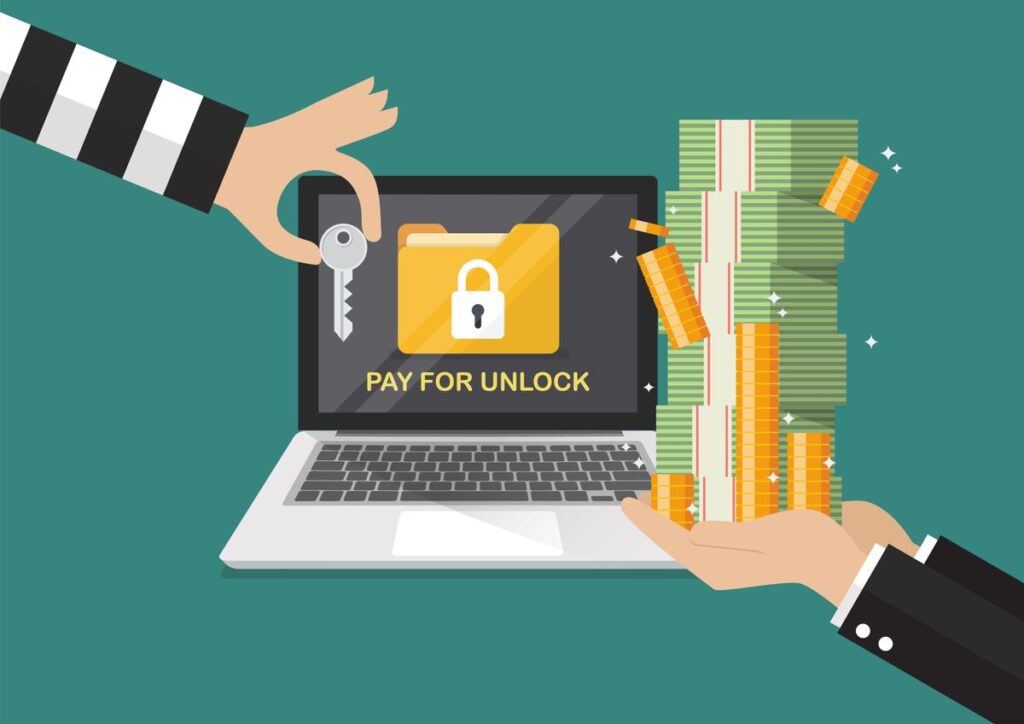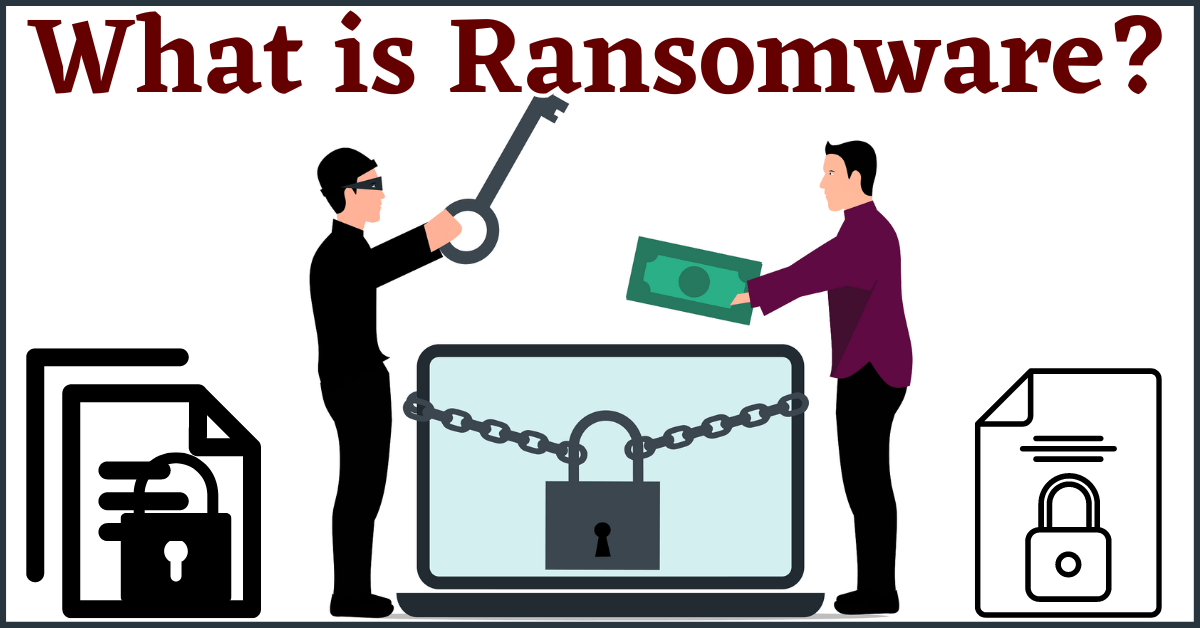In recent years, ransomware attacks have surged in frequency and sophistication. As an internet user, understanding what is ransomware and how it operates is crucial for protecting your data and devices.
This article will delve into the details of ransomware, including how it works, real-world examples, and its relationship to other types of malware.
Table of Contents
What is Ransomware?
Knowing what is ransomware can assist in implementing effective security measures to prevent such attacks.
The term “ransomware” combines two words: “ransom” and “malware.” Ransomware is a particularly dangerous type of malware.
You’ve likely heard about ransom in movies, where criminals kidnap someone and demand a specific amount of money from their family. Ransomware operates on a similar concept. In this case, the “bad guys” are cybercriminals or hackers, the “kidnapped” are your files and data, and the “family” is the owner of the computer.
Here’s how it works: Cybercriminals use viruses or other types of malware to hack into your computer. Once they gain access, they encrypt your important files or even lock your entire computer. Regular users can’t decrypt the files because hackers use special software to encrypt and decrypt them. As a result, they demand a ransom to unlock your files.
Click here to read more on Encryption.
Most users feel they have no choice but to pay the ransom. If they refuse, the hackers may delete all the files. Even after paying, there’s no guarantee that your files will be returned safely. Therefore, it’s better to prevent ransomware attacks in the first place.
Check out all methods on How to Prevent Ransomware.

How Does Ransomware Work?
Ransomware operates through several stages, each designed to compromise your system and force you into paying a ransom. Here’s a simplified breakdown of how ransomware works:
- Infection: The ransomware typically infiltrates a system through phishing emails, malicious attachments, or compromised software downloads. Once executed, it begins to infect the system.
- Encryption: The ransomware encrypts files on the infected system. Encryption is a process that converts data into a code to prevent unauthorized access. The ransomware uses a unique encryption key that only the attacker has.
- Ransom Demand: After encryption, the ransomware displays a ransom note on the victim’s screen. This note instructs the user on how to pay the ransom, often in cryptocurrency like Bitcoin, to receive the decryption key.
- Payment and Decryption: If the victim pays the ransom, the attacker might provide a decryption key to restore access to the encrypted files. However, there is no guarantee that the attacker will fulfill their promise. Even after payment, the decryption key might not work, or the attacker may demand additional payments.
Ransomware Examples
Several notable ransomware attacks have made headlines over the years. Here are a few prominent examples:
- WannaCry (2017): One of the most notorious ransomware attacks, WannaCry spread rapidly across the globe, encrypting files on over 200,000 computers in 150 countries. It exploited a vulnerability in Microsoft Windows and demanded ransom payments in Bitcoin. The attack disrupted hospitals, businesses, and government agencies.
- Petya/NotPetya (2017): Initially thought to be a variant of the Petya ransomware, NotPetya was later identified as a destructive cyber attack. It encrypted files and rendered systems inoperable, causing widespread damage to companies and institutions.
- Ryuk (2018-present): Ryuk is a sophisticated ransomware strain often associated with targeted attacks on large organizations. It encrypts files and demands high ransom payments. Ryuk is known for its precise targeting and high ransom demands.

How to Remove Ransomware
If your system is infected with ransomware, the first step is to remove the ransomware. Here’s how you can approach it:
- Disconnect from the Internet: To prevent further damage, disconnect your computer from the internet immediately. This action helps prevent the ransomware from spreading and stops any additional communication with the attacker.
- Use Antivirus Software: Run a comprehensive scan using reputable antivirus or anti-malware software. Many security vendors provide tools specifically designed to detect and remove ransomware.
- Restore from Backup: If you have a recent backup of your files, restore them after removing the ransomware. Ensure the backup is clean and not connected to the infected system.
- Seek Professional Help: If you’re unable to remove the ransomware on your own, consider seeking help from a professional. Cybersecurity experts can assist with decryption and removal.
- Report the Attack: Report the ransomware attack to local authorities or cybercrime units. They can provide guidance and help track down the attackers.
Ransomware removal can be complex, often requiring specialized tools and professional assistance to decrypt files and remove the malware.
Real-World Examples of Ransomware Attacks
Ransomware attacks can affect individuals, businesses, and even entire cities. Here are some real-world scenarios:
- Baltimore Ransomware Attack (2019): The city of Baltimore was hit by a ransomware attack that crippled several government systems. The attackers demanded a ransom of 13 bitcoins, which was worth around $76,000 at the time. The city chose not to pay, and recovery efforts took several months.
- Travelex Attack (2020): Travelex, a global foreign exchange company, was targeted by the REvil ransomware group. The attack disrupted services worldwide, and the attackers demanded a ransom of $6 million in Bitcoin. The company faced significant operational challenges as a result.
- Colonial Pipeline Attack (2021): Colonial Pipeline, one of the largest fuel pipeline operators in the U.S., suffered a ransomware attack that disrupted fuel supplies across the East Coast. The attackers, identified as the DarkSide group, demanded a ransom of $4.4 million. Colonial Pipeline paid the ransom but faced severe operational and reputational damage.

Ransomware and Its Relation to Other Malware
Understanding ransomware’s connection to other types of malware is essential for comprehensive cybersecurity. Here’s how ransomware fits into the broader malware landscape:
- Types of Malware: Ransomware is one type of malware. Other types include viruses, worms, Trojans, and spyware. Each type has its own methods of attack and impact on systems.
- What is a Trojan?: A Trojan is a type of malware that disguises itself as a legitimate program to trick users into installing it. Some ransomware strains use Trojan techniques to gain access to systems. Learn more about What is a Trojan.
- Pegasus Spyware: Pegasus is a sophisticated spyware developed by the NSO Group. It can be used to monitor and extract data from devices without the user’s knowledge. While not ransomware, it represents a significant threat in the malware spectrum. Find out more about Pegasus Spyware.
- What is a Botnet?: A botnet is a network of compromised computers controlled by an attacker. Botnets can be used to distribute ransomware, conduct denial-of-service attacks, or steal data. Discover more about What is a Botnet.
- What is a Rootkit?: A rootkit is a type of malware designed to gain unauthorized access to a computer while avoiding detection. Rootkits can be used to install and hide ransomware. Learn more about What is a Rootkit?.
How to Recognize a Ransomware Attack
Detecting a ransomware attack early can help minimize damage. Here are some signs that your system might be infected:
- Unusual File Extensions: Ransomware often changes file extensions to indicate encryption. For example, a file might change from Document.docx to Document.docx.locked. The presence of unfamiliar file extensions can be a warning sign.
- Ransom Notes: Look for ransom notes on your screen or in your files. These notes typically provide instructions for payment and may include threats of file deletion or permanent encryption if the ransom is not paid.
- System Performance Issues: A sudden slowdown in system performance, unusual system behavior, or frequent crashes can indicate a ransomware infection.
- Locked Files or Systems: If you are unable to access files or if your system is locked with a message demanding a ransom, it’s likely that ransomware has compromised your system.

Frequently Asked Questions about Ransomware
1. What is ransomware?
Ransomware is malicious software that locks or encrypts your files and demands payment to unlock them.
2. How does ransomware work?
It infects your system, encrypts your files or locks your system, and then demands a ransom for access.
3. What are some common types of ransomware?
Common types include CryptoLocker, WannaCry, Ryuk, and Locky.
4. What is Ransomware Attack?
To grasp what is ransomware attack, think of it as a form of digital kidnapping where your data is held hostage.
5. What should I do if I become a victim of ransomware?
Disconnect from the internet, don’t pay the ransom, and seek professional help.
6. Is ransomware a type of malware?
Yes, ransomware is a type of malware designed to block access to your data.
7. Can ransomware be removed?
Yes, with antivirus tools, but it may not restore encrypted files. Backups help with recovery.
8. How much does ransomware typically demand?
Demands vary, from a few hundred to several thousand dollars, often paid in cryptocurrencies.
9. Can I recover my files without paying the ransom?
Yes, if you have backups or a decryption tool for that specific ransomware.
10. How can I identify if my system is infected with ransomware?
Look for encrypted files, ransom notes, or unusual system behavior.
Conclusion
Ransomware is a serious threat with significant implications for individuals and organizations alike. By understanding what is ransomware, how it works, and recognizing its signs, you can better protect yourself from these malicious attacks. For additional protection, ensure you follow the guidelines outlined in How to Prevent Ransomware, stay informed about different types of malware, and be vigilant against potential threats.
Remember, while paying a ransom might seem like a quick fix, it’s not always a guaranteed solution. The best defense is prevention and preparedness. Keep your systems updated, back up your data regularly, and stay informed about the latest cybersecurity threats.

